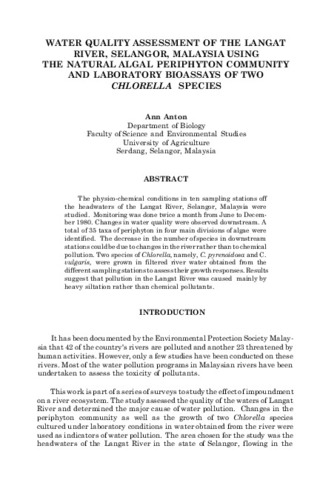Sugar mill effluents and water quality in Imbang River and Malisbog River, Negros Occidental
| dc.contributor.author | Gonzales, Hernane J. | |
| dc.contributor.editor | Bagarinao, Teodora | |
| dc.date.accessioned | 2018-02-23T06:06:58Z | |
| dc.date.available | 2018-02-23T06:06:58Z | |
| dc.date.issued | 2007 | |
| dc.identifier.citation | Gonzales, H. J. (2008). Sugar mill effluents and water quality in Imbang River and Malisbog River, Negros Occidental. In T. U. Bagarinao (Ed.), Research Output of the Fisheries Sector Program (Vol. 2. Reports on Fisheries and Aquaculture, pp. 71-76). Quezon City, Philippines: Bureau of Agricultural Research, Department of Agriculture. | en |
| dc.identifier.isbn | 9718511776 | |
| dc.identifier.uri | http://hdl.handle.net/10862/3266 | |
| dc.description.abstract | The effluents of two sugar mills and the effects on water quality in the receiving rivers were studied. Sugar mill A was located in Barangay Dos Hermanas in Talisay and discharged directly into Imbang River. Sugar Mill B was located in Barangay Hawaiian in Silay City and discharged into Malisbog River, a tributary of Imbang. Both sugar mills had sedimentation tanks and lagoons for partial wastewater treatment prior to discharge. Water sampling was done at 13 stations at effluent discharge sites and also upstream and downstream of these sites. The sugar mill effluents were particularly high in biochemical oxygen demand (BOD 109–419 mg/l), total suspended solids (168–384 mg/l), and total solids (1,185–1,234 mg/l), also high in ammonia (0.2–0.5 mg/l) and water temperature (31–38°C), but low in dissolved oxygen (2–5 mg/l). Measured stream flows varied at the different stations and were generally lowest at stations near sugar mill A and at stations near sugar mill B. At these sites, the depth of Imbang River varied from about 10 cm during low water flow in December–May to about 2 m during high water flow in June–November. During normal low flows, the sugar mill effluent comprised 75–85% of the total stream volume, causing highly polluted conditions immediately below the outlets. Sugar mill A discharged high annual loads of solids, BOD, nitrate, and phosphate into Imbang River, whereas sugar mill B loaded plenty of solids, BOD, ammonia, and phosphate into Malisbog River. The sugar cane milling season in Negros Occidental started in October and ended in May, coincident with the dry season. Significantly higher levels of BOD and nutrients, but lower DO, were observed in the river during the milling season (see figures in Gonzales et al., this volume), both because of greater discharge and lower dilution by lower stream flows. River water quality was better at the stations upstream than downstream of the sugar mills. Stations near the sugar mills had BOD, ammonia, and solids at concentrations exceeding the allowable limits set for river water by the Department of Environment and Natural Resources. | en |
| dc.language.iso | en | en |
| dc.publisher | Bureau of Agricultural Research, Department of Agriculture | en |
| dc.subject | Philippines | en |
| dc.title | Sugar mill effluents and water quality in Imbang River and Malisbog River, Negros Occidental | en |
| dc.type | Book chapter | en |
| dc.citation.spage | 71 | |
| dc.citation.epage | 76 | |
| dc.citation.bookTitle | Research Output of the Fisheries Sector Program | en |
| dc.subject.asfa | industrial wastes | en |
| dc.subject.asfa | suspended particulate matter | en |
| dc.subject.asfa | freshwater pollution | en |
| dc.subject.asfa | pollution effects | en |
| dc.subject.asfa | water quality | en |
| dc.subject.asfa | rivers | en |
| dc.subject.asfa | biochemical oxygen demand | en |
このアイテムのファイル
| ファイル | サイズ | フォーマット | 閲覧 |
|---|---|---|---|
|
このアイテムに関連するファイルは存在しません。 |
|||




